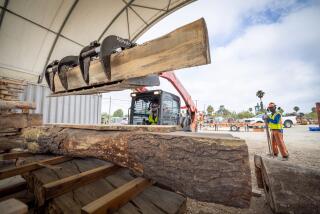Paying the Price for Logging on the Cheap
- Share via
When George W. Bush poses for a photo op in a burned-over public forest, he’s right about one thing: It’s a shame what we’ve done. And it’s a worse shame what we’re doing--more of the same, squandering the last of our treasure just about as fast as we can.
There is always an excuse for logging public forests on the cheap. During Bill Clinton’s administration, the excuse was jobs. Now it’s fires. Tomorrow it will be something else. I’ll take a guess: We’ll thin the forests in the guise of reducing fire danger then we’ll have a series of big El Nino storms. Because the canopy is thinned out, trees won’t be able to rely on each other to share the work of breaking the wind. There will be massive blow-downs. We’ll have to rush in and “salvage” that lumber too.
Taxpayers will subsidize all this--paying more for the logging roads and survey work than they receive in timber sales. But managing public forests at a loss is nothing new. And as long as we’re going to have a 19th century approach to our forests, why change the fundamentals, eh?
The Big Lie that we’re asked to believe is that our public forests are managed as a “sustainable” resource. That when trees are cut, new ones are planted, sometimes two for one. When a timber broker feeds you that bull, ask whether he would trade you that piece of green paper in his wallet that says $100 for two pieces of the same paper that say $1. That’s what passes for sustainable forestry.
I’m a tree hugger, yes. But I’m also a tree user. I’m a woodworker in my free time, not to mention I earn my living thanks to the availability of newsprint. The maddening truth is that conservation and consumption are not incompatible when it comes to trees--never mind the contrary tone of our dead-end debates about national forests. You can love forests as the place where nature reaches full glory, as havens for animals and cathedrals for our soul. At the same time, you can cherish them as a storehouse for that most tactile, warm and beautiful of our raw materials.
We could enjoy our forests for both purposes and for generations to come if only we regarded trees for their value, not their volume. Too bad we’re running out of time. When a 500-year-old fir is cut down and peeled into plywood to be nailed on a wall and covered with paint, a sensible person would say that something is wrong. It’s like the mugger who steals a Rolex and pawns it for $50 and considers himself ahead. A 500-year-old tree has far greater social value standing in the forest than loggers pay to cut it down. Likewise, these trees are worth more on the market as the ingredients for heirloom furniture and large-dimension architectural display features than as cheap wallboard.
Sadly, that wood may disappear before we recognize it. Only after the Japanese and the Europeans cut down their forests did they understand the value of ours. Today, straight-grained fir logs from the Pacific Northwest can command six or 10 times as much abroad as they do at home.
How can this be happening? Simple. In the antediluvian mind of the American lumbermen, wood is just fiber measured by board-feet. Old trees grow slower than young ones. Thus, there is a premium on ridding forests of the biggest trees for quick profit, making way for saplings. Timber lobbyists like to use agricultural analogies. But they overlook the fact that if you harvest all of your pumpkins when they are one inch around, you don’t have much to offer come Halloween. No industry in the land is run with such little imagination and brazen profligacy.
What can we do? Also simple. We acknowledge that a 200-foot tree has more significance in the forest than 10 20-footers. That’s both for the sake of humans who visit and creatures that depend on it. We shouldn’t allow these trees to be cut for less than the standing value of leaving them alone. And when big trees are felled, it should be at a rate no faster than they can replenish themselves. That’s sustainable harvesting in the honest meaning of the term.
But that will make them too expensive, you say. No, it won’t. We’ll come to realize the value of what we have before it’s gone. Yes, this wood would cost more, and it should. That way, our great-grandchildren will have trees in their public forests that make them crane their necks to behold. And we’ll have beautiful, mature wood, now and tomorrow, worthy of dining room tables and ceiling beams and wood-strip canoes--things that bring the pleasure of nature into our everyday lives.


